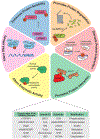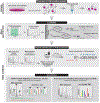A field guide to the proteomics of post-translational modifications in DNA repair
- PMID: 35695711
- PMCID: PMC9950963
- DOI: 10.1002/pmic.202200064
A field guide to the proteomics of post-translational modifications in DNA repair
Abstract
All cells incur DNA damage from exogenous and endogenous sources and possess pathways to detect and repair DNA damage. Post-translational modifications (PTMs), in the past 20 years, have risen to ineluctable importance in the study of the regulation of DNA repair mechanisms. For example, DNA damage response kinases are critical in both the initial sensing of DNA damage as well as in orchestrating downstream activities of DNA repair factors. Mass spectrometry-based proteomics revolutionized the study of the role of PTMs in the DNA damage response and has canonized PTMs as central modulators of nearly all aspects of DNA damage signaling and repair. This review provides a biologist-friendly guide for the mass spectrometry analysis of PTMs in the context of DNA repair and DNA damage responses. We reflect on the current state of proteomics for exploring new mechanisms of PTM-based regulation and outline a roadmap for designing PTM mapping experiments that focus on the DNA repair and DNA damage responses.
Keywords: LC-MS/MS, technology, bottom-up proteomics, technology, signal transduction, cell biology; phosphoproteomics, technology, post-translational modification analysis, technology, post-translational modifications, cell biology, mass spectrometry.
© 2022 Wiley-VCH GmbH.
Figures



Similar articles
-
Proteomics insights into DNA damage response and translating this knowledge to clinical strategies.Proteomics. 2017 Feb;17(3-4):1600018. doi: 10.1002/pmic.201600018. Epub 2016 Dec 12. Proteomics. 2017. PMID: 27682984 Free PMC article. Review.
-
The Methods Employed in Mass Spectrometric Analysis of Posttranslational Modifications (PTMs) and Protein-Protein Interactions (PPIs).Adv Exp Med Biol. 2019;1140:169-198. doi: 10.1007/978-3-030-15950-4_10. Adv Exp Med Biol. 2019. PMID: 31347048 Free PMC article. Review.
-
The top-down, middle-down, and bottom-up mass spectrometry approaches for characterization of histone variants and their post-translational modifications.Proteomics. 2014 Mar;14(4-5):489-97. doi: 10.1002/pmic.201300256. Epub 2013 Dec 16. Proteomics. 2014. PMID: 24339419 Review.
-
Identification, Quantification, and Site Localization of Protein Posttranslational Modifications via Mass Spectrometry-Based Proteomics.Adv Exp Med Biol. 2016;919:345-382. doi: 10.1007/978-3-319-41448-5_17. Adv Exp Med Biol. 2016. PMID: 27975226 Review.
-
Post-translational modifications of proteins in cardiovascular diseases examined by proteomic approaches.FEBS J. 2025 Jan;292(1):28-46. doi: 10.1111/febs.17108. Epub 2024 Mar 5. FEBS J. 2025. PMID: 38440918 Free PMC article. Review.
Cited by
-
N4-acetylcytidine and other RNA modifications in epitranscriptome: insight into DNA repair and cancer development.Epigenomics. 2025 Apr;17(6):411-422. doi: 10.1080/17501911.2025.2473308. Epub 2025 Mar 5. Epigenomics. 2025. PMID: 40040517 Free PMC article. Review.
-
Skin Fibroblasts from Individuals Self-Diagnosed as Electrosensitive Reveal Two Distinct Subsets with Delayed Nucleoshuttling of the ATM Protein in Common.Int J Mol Sci. 2025 May 16;26(10):4792. doi: 10.3390/ijms26104792. Int J Mol Sci. 2025. PMID: 40429933 Free PMC article.
-
Cryogenic mouse tissue homogenization as an alternative to fresh-frozen biopsy use for genomics, transcriptomics, proteomics and metabolomics.Sci Rep. 2025 Jun 23;15(1):20254. doi: 10.1038/s41598-025-06438-3. Sci Rep. 2025. PMID: 40550841 Free PMC article.
-
A Tutorial Review of Labeling Methods in Mass Spectrometry-Based Quantitative Proteomics.ACS Meas Sci Au. 2024 Apr 15;4(4):315-337. doi: 10.1021/acsmeasuresciau.4c00007. eCollection 2024 Aug 21. ACS Meas Sci Au. 2024. PMID: 39184361 Free PMC article. Review.
References
-
- Hanahan D, Weinberg RA, Hallmarks of cancer: The next generation. Cell 2011, 144, 646–674. - PubMed
-
- Hanahan D, Weinberg RA, The hallmarks of cancer. Cell 2000, 100, 57–70. - PubMed
-
- German J, Archibald R, Bloom D, Chromosomal breakage in a rare and probably genetically determined syndrome of man. Science 1965, 148, 506–507. - PubMed
-
- Ellis NA, Groden J, Ye TZ, Straughen J, et al., The Bloom’s syndrome gene product is homologous to RecQ helicases. Cell 1995, 83, 655–666. - PubMed
-
- Thompson LH, Schild D, Recombinational DNA repair and human disease. Mutat. Res.Fundam. Mol. Mech. Mutagen 2002, 509, 49–78. - PubMed
Publication types
MeSH terms
Grants and funding
LinkOut - more resources
Full Text Sources
Miscellaneous

